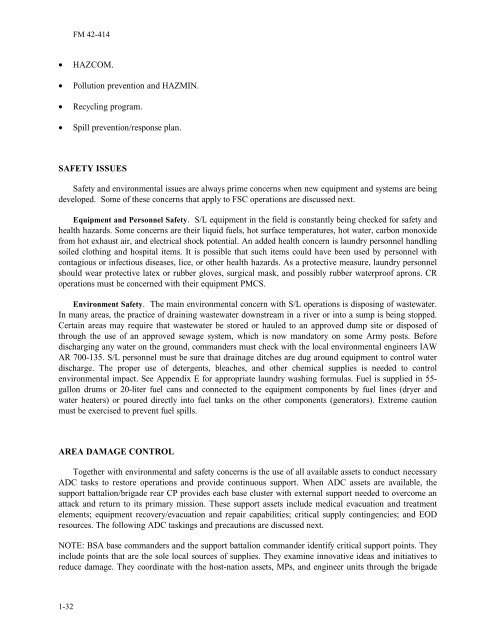Tactics, techniques, and procedures for - Army Electronic ...
Tactics, techniques, and procedures for - Army Electronic ...
Tactics, techniques, and procedures for - Army Electronic ...
You also want an ePaper? Increase the reach of your titles
YUMPU automatically turns print PDFs into web optimized ePapers that Google loves.
1-32<br />
FM 42-414<br />
• HAZCOM.<br />
• Pollution prevention <strong>and</strong> HAZMIN.<br />
• Recycling program.<br />
• Spill prevention/response plan.<br />
SAFETY ISSUES<br />
Safety <strong>and</strong> environmental issues are always prime concerns when new equipment <strong>and</strong> systems are being<br />
developed. Some of these concerns that apply to FSC operations are discussed next.<br />
Equipment <strong>and</strong> Personnel Safety. S/L equipment in the field is constantly being checked <strong>for</strong> safety <strong>and</strong><br />
health hazards. Some concerns are their liquid fuels, hot surface temperatures, hot water, carbon monoxide<br />
from hot exhaust air, <strong>and</strong> electrical shock potential. An added health concern is laundry personnel h<strong>and</strong>ling<br />
soiled clothing <strong>and</strong> hospital items. It is possible that such items could have been used by personnel with<br />
contagious or infectious diseases, lice, or other health hazards. As a protective measure, laundry personnel<br />
should wear protective latex or rubber gloves, surgical mask, <strong>and</strong> possibly rubber waterproof aprons. CR<br />
operations must be concerned with their equipment PMCS.<br />
Environment Safety. The main environmental concern with S/L operations is disposing of wastewater.<br />
In many areas, the practice of draining wastewater downstream in a river or into a sump is being stopped.<br />
Certain areas may require that wastewater be stored or hauled to an approved dump site or disposed of<br />
through the use of an approved sewage system, which is now m<strong>and</strong>atory on some <strong>Army</strong> posts. Be<strong>for</strong>e<br />
discharging any water on the ground, comm<strong>and</strong>ers must check with the local environmental engineers IAW<br />
AR 700-135. S/L personnel must be sure that drainage ditches are dug around equipment to control water<br />
discharge. The proper use of detergents, bleaches, <strong>and</strong> other chemical supplies is needed to control<br />
environmental impact. See Appendix E <strong>for</strong> appropriate laundry washing <strong>for</strong>mulas. Fuel is supplied in 55gallon<br />
drums or 20-liter fuel cans <strong>and</strong> connected to the equipment components by fuel lines (dryer <strong>and</strong><br />
water heaters) or poured directly into fuel tanks on the other components (generators). Extreme caution<br />
must be exercised to prevent fuel spills.<br />
AREA DAMAGE CONTROL<br />
Together with environmental <strong>and</strong> safety concerns is the use of all available assets to conduct necessary<br />
ADC tasks to restore operations <strong>and</strong> provide continuous support. When ADC assets are available, the<br />
support battalion/brigade rear CP provides each base cluster with external support needed to overcome an<br />
attack <strong>and</strong> return to its primary mission. These support assets include medical evacuation <strong>and</strong> treatment<br />
elements; equipment recovery/evacuation <strong>and</strong> repair capabilities; critical supply contingencies; <strong>and</strong> EOD<br />
resources. The following ADC taskings <strong>and</strong> precautions are discussed next.<br />
NOTE: BSA base comm<strong>and</strong>ers <strong>and</strong> the support battalion comm<strong>and</strong>er identify critical support points. They<br />
include points that are the sole local sources of supplies. They examine innovative ideas <strong>and</strong> initiatives to<br />
reduce damage. They coordinate with the host-nation assets, MPs, <strong>and</strong> engineer units through the brigade

















